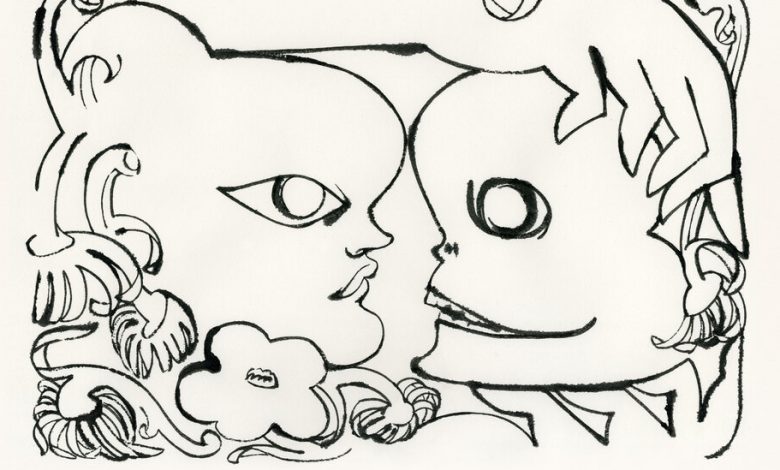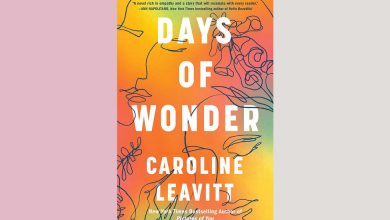This Above All: My Undying Obsession With ‘Hamlet’

A few weeks ago two friends and I were talking about our obsessions. One had been sleepless all week, playing the new Zelda video game with few breaks. The other revealed that she was deep into Taylor Swift. I said I had so many fandoms that I didn’t know if I could name a favorite.
My Swiftie friend quickly set me straight. “We already know your main fandom,” she said. “Hamlet.”
It’s true. If you look at my bookshelves, the art on my walls, even the art on my skin, you’ll find anime references and mythological figures, lines from Eliot and Chekhov and illustrations from Borges and Gorey stories. But none of these interests enjoys a prominence as great as the one afforded “Hamlet” in my home — and on my body, where the majority of my tattoos, by far, are inspired by the play.
My friends know well that I’ve seen numerous productions of the work, recite Hamlet’s monologues to myself, even put Kenneth Branagh or Laurence Olivier’s “Hamlet” on in the background as I clean my apartment. For me, the text’s themes — about death, duality, gender, family — deepen each time I read, see or hear “Hamlet,” and as I grow older, new insights are revealed about the characters and the language.
I first read “Hamlet” in high school, as an artsy poetry-writing teenager who found death a fascinating, albeit abstract, concept. I imagined the young prince — witty, privileged yet tortured, and forever trapped in his own head — as kin. He was less a lofty figure of English literature than the emo kid I crushed on, abandoning his math homework to read Dante’s “Inferno” as angsty pop punk played in the background.
When I watched Michael Almereyda’s 2000 “Hamlet” film soon after, it did little to disabuse me of this notion. Taking place in New York City, with Ethan Hawke playing a hipster film student who’s heir to the “Denmark Corporation,” this “Hamlet” was contemporary, rife with irony. Watching Hamlet offer the great existential query of “to be or not to be” while strolling the “action movie” aisles of a Blockbuster store, I learned that even tragedy can contain a hearty dose of comedy.
When I reread the play for a class on Shakespeare’s tragedies a few years later, I became fixated on one line in particular: “The rest is silence.” With these four words, Hamlet’s last ones in the play, the prince is acknowledging his final breath, but also perhaps breaking the fourth wall, announcing the end of the play like Prospero at the end of “The Tempest.” Or maybe Hamlet is offering us the line in consolation: After five acts of musing on death, he can assure us that death is simple, and it’s quiet. This line is now tattooed on my right arm.
In Branagh’s 1996 “Hamlet” film, an unabridged adaptation that paired inspired direction with refined performances and respect for the text, Branagh wheezes out the words, his eyes glassy and staring into the distance. “Silence” lands after a pause, as though he’s listening to the deafening silence of all of humanity that’s preceded him.






Clockwise from top left: Laurence Olivier as Hamlet in the 1948 film, Ethan Hawke in the 2000 film, Kenneth Branagh in his 1996 film, Ato Blankson-Wood (with Solea Pfeiffer as Ophelia) in the 2023 Shakespeare in the Park production, Ruth Negga in the 2020 production at St. Ann’s Workshop, and Billy Eugene Jones, left, and Marcel Spears in 2022 Public Theater production of “Fat Ham.”
From Olivier’s fervent philosophizing Dane in the 1948 film to David Tennant’s lithe, boyish interpretation in the Royal Shakespeare Company’s 2008 production, there’s a reason that Prince Hamlet remains one of the most coveted roles an actor, especially a young man of a certain age and celebrity, can take on. “Hamlet” is, after all, a man’s play.
In Hawke’s “Hamlet” and Mel Gibson’s visceral, sensually charged 1990 “Hamlet” I first realized how often directors use the female characters as stand-ins for fatalistic, taboo love. (Which is why I also savor gender-crossed Hamlets, whether in the form of the theater pioneer Sarah Bernhardt in 1899 or Ruth Negga in 2020.) Queen Gertrude is either stupid, selfish or promiscuous, blinded by her untamed lust. Many productions opt for a physical staging of Act III, Scene 4, when Hamlet accosts his mother in her bedchamber. Hawke’s Hamlet grabs his mother in a black robe, then presses her against a set of closet doors. Gibson’s deranged Hamlet also fights and clutches at Gertrude, as did Andrew Scott’s in the 2017 London production by Robert Icke. Thomas Ostermeier’s wild “Hamlet” at the Brooklyn Academy of Music last year emphasized Gertrude’s sexuality to an extreme, having her slink and shimmy as though overwhelmed with sexual energy. The text implies that a woman too free with her affections digs her own grave.
That includes, of course, Hamlet’s eternally damned love interest, Ophelia (memorialized on my right forearm with a skull and pansy). I used to dismiss her as a frail female stereotype, and have craved a production or adaptation that could give this character agency — any kind of agency — within the space of her grieving, her madness and her death.
Kenny Leon’s otherwise underwhelming “Hamlet” at the Delacorte this summer did just that. Solea Pfeiffer played an Ophelia who matched Hamlet in wit and sass, who spoke with a knowingness and rage that lifted the character from her 17th-century home into the present.
This duality in Ophelia — between sincerity and performance, raving madness and clear, articulated rage — is welcome. It’s a duality that many directors literalize in their productions overall, some using mirrors as nods to Hamlet’s constant reflections at the expense of action, others turning to hint at the divide between presentation and truth.
But as much as “Hamlet” can serve as a character study, for me the story extends far beyond a production’s conceptualization of a lost prince with a splintered ego. This is a story that begins and ends with grief.
I have a tattoo for Hamlet and his dear, departed father — a jeweled sword piercing a cracked skull in a crown. Having lost my dad almost a decade ago, I’m familiar with the feeling of being haunted by a father who may not be a literal king but perhaps just a patriarch taking the same cheap shots from the afterlife, like Pap in James Ijames’s “Fat Ham.” In the play, a Black, queer take on “Hamlet” in conversation with Shakespeare’s original text, Hamlet is not just tied to his father through a sense of filial obligation but also through guilt, regret, shame. In Pap I saw my own father’s flaws — the spite, the prejudice, the toxic masculinity. It made me wonder how much of Hamlet’s grief is for his father, and how much for the stability his father symbolized.
Lately I’ve been listening with more regularity to Hamlet’s “To be or not to be” monologue, that great conference with death that feels as germane to the English language — our rhetoric, our poetry, our elocution, our linguistic imagination — as soil to the Earth. In the span of about a week this summer, I lost a grandmother, and a dear friend shared that his cancer had returned. Having buried both her parents in the past two years, my mother has been talking more about funeral arrangements and where our family would like to spend our post-mortem days. I, on the other hand, take less stock in the expensive ceremonies and planning around death. I don’t plan to make a show of my finale; like Hamlet, I wonder what it will even mean — in that everlasting sleep, who knows what dreams will come?
I didn’t fall in love with “Hamlet” because of its action and intrigue; I love the play because it lets me reconnect with the spaces where death has brushed my life. “Hamlet” helps me sit with my own existential fears, all packaged in words of wit and elegance. Because I’m convinced now that if you let Shakespeare in, his voice becomes the one bellowing from the backstage of your life.



